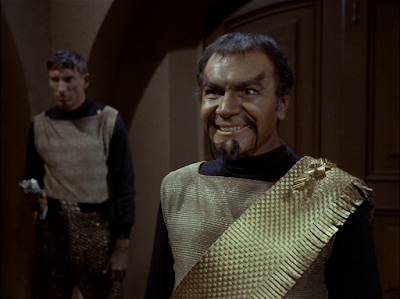Talking About 'Star Trek': Why do the Klingons in Star Trek TOS look different than the Klingons in Star Trek TNG and the rest of Star Trek series?
 |
| John Colicos (as Kor) in original "swarthy" Klingon makeup and prosthetic Fu Manchu facial hair. © 1967 CBS Studios |
Why do the Klingons in Star Trek TOS look different than the Klingons in Star Trek TNG and the rest of Star Trek series?
When Gene L. Coon and Gene Roddenberry created the Klingons as the 23rd Century avatars for the Soviet Union to serve as foils for America’s avatar, the United Federation of Planets in 1967, the new aliens were depicted as swarthy-looking humanoids with extra-bushy eyebrows and, in the case of Kor (John Colicos), a villainous-looking Fu Manchu mustache-and-goatee.
Sometimes, though, the Klingons would have pigment variations and on occasion, such as in The Trouble with Tribbles, we’d see fair-haired Klingons alongside the basic Klingon-with-swarthy-makeup.
Sometimes, though, the Klingons would have pigment variations and on occasion, such as in The Trouble with Tribbles, we’d see fair-haired Klingons alongside the basic Klingon-with-swarthy-makeup.
 |
| William Campbell (Koloth) and Michael Pataki (Krax) in The Trouble With Tribbles. Note absence of swarthy makeup and more "Western-style" goatees. © 1967 CBS Studios |
Remember, in 1966–1969, Star Trek was a one-off TV series on the NBC television network, not a massive franchise with several feature films and TV sequels/prequels under its belt. It was produced for a modest amount of money (about $300,000 per episode), and because the suits at 30 Rockefeller Plaza didn’t think science fiction shows would amount to anything, NBC never increased Star Trek’s production budget. (From the executives’ collective point of view, Roddenberry’s show simply didn’t bring in stellar ratings, and although Star Trek had a core of dedicated fans, NBC thought the demographics simply were not there to justify giving Desilu/Paramount/Norway Productions more money.)
With those limitations frozen firmly into place, makeup designer Fred Phillips had to make do with what he had for the Klingons: namely, swarthy makeup and facial hair prosthetics. William Ware Theiss, the show’s ingenious costume designer, also had to create costumes that were the antithesis of Starfleet’s uniforms. Klingon uniforms in the TOS era had to look vaguely evil (hence the use of black undertunics) and militaristic utilitarian lines.
 |
| The "new and improved" Klingons from Star Trek: The Motion Picture are the basis for the Klingons in later Star Trek TV series. © 1979 Paramount Pictures |
When asked why the Klingons in Star Trek: The Motion Picture looked so radically different from the ones in TOS, Gene Roddenberry had two stock answers, one which was serious - if perhaps a bit self-serving - and one which was a joke.
Roddenberry’s comical explanation was, “Well, the Klingons in the TV show were northern Klingons, while those in the movie are southern Klingons!”
The not-so-jokey reply was, of course, “Fred Phillips and I always wanted to make our Klingons look like that, but we simply didn’t have the resources to do it that way.”

.jpg)

Comments
Post a Comment